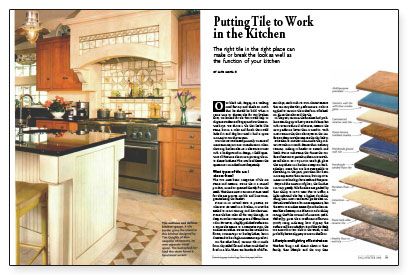Putting Tile to Work in the Kitchen
The right tile in the right place can make or break the look as well as the function of your kitchen.

Synopsis: This design sampler shows the possibilities for using different types of tile in a kitchen. Not a how-to guide for installing tile, but a general discussion of its pros and cons as well as suggestions for choosing field tile, borders, and murals.
Our black Lab, Bogey, is a walking mud factory and sheds so much that he should be bald. When it came time to choose tile for our kitchen floor, we looked for tile that would help to disguise evidence of Bogey and our three active boys. We chose a tile that looks like stone, but in a color and finish that could hide dirt and dog hair until I had a spare moment to run the vacuum.
Our choice was based primarily on ease of maintenance, just one consideration when choosing kitchen tile. As a tile-store owner with a background in design, I field questions all the time about incorporating tile into clients’ kitchens. This article addresses the questions I am asked most frequently.
What types of tile can I choose from?
The two most basic categories of tile are stone and ceramic. Stone tile is a natural product, mined or quarried directly from the earth. The three most common stones used for tile are granite, marble and limestone, granite being the hardest.
Stone in its natural state is porous, so wherever it’s used in a kitchen, it must be sealed to resist staining and discoloration. Stone tile has color all the way through, so deep scratches won’t expose a different base color. However, a highly polished surface on a stone tile seems to accentuate even the smallest scratches. Stone can be installed on floors, countertops or backsplashes, but it does tend to be a high-maintenance product.
On the other hand, ceramic tile is made from clay rolled flat and either sun-baked or fired in a kiln. There are hundreds of different clays, each with its own characteristics that can vary the tile’s performance. Color is applied to ceramic tile in the form of bakedon glazes that also seal the tile.
In the past, ceramic-tile finishes had problems standing up to heavy use and abuse, but with recent technical advances, ceramic tile now performs better than it used to. With most ceramic tile, the color is just on the surface, so deep scratches expose the clay below.
Porcelain is another man-made tile product. Porcelain is much denser than ordinary ceramic, making it harder to scratch and break. But as with stone, the shinier the surface of ceramic or porcelain, the more scratches will show. So I try not to use high-gloss tiles anywhere in a kitchen except on backsplashes, areas that are less susceptible to scratching. In the past, porcelain has been more expensive than ceramic, but improvements in technology have reduced the price.
For more photos and details, click the View PDF button below:
Fine Homebuilding Recommended Products
Fine Homebuilding receives a commission for items purchased through links on this site, including Amazon Associates and other affiliate advertising programs.

Original Speed Square

Smart String Line

100-ft. Tape Measure






















